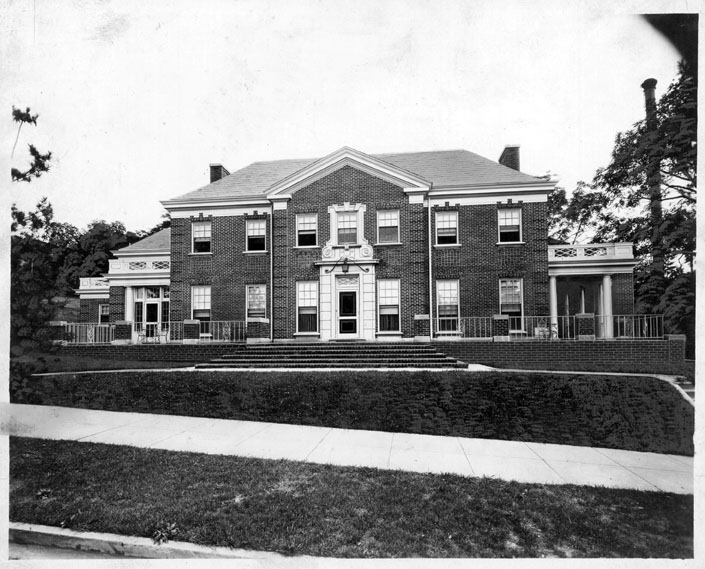Author’s note: This week’s Archives takes place during segregation in the Jim Crow South. Therefore, the social benefits discussed in the following piece excluded African Americans and other people of color.
In a Jan. 28, 1917, editorial, The Asheville Citizen observed how “all the good things that Asheville has secured, for the most part, have benefitted the men of the city.” As the paper pointed out, men’s organizations like the YMCA, the Board of Trade, the Asheville Club and the fraternal orders of the Masons and Elks all had “magnificent buildings of their own.”
Meanwhile, the editorial continued, the city’s women’s groups “have no club building that they might call home.”
But that was soon to change, the article reported. The Asheville Club for Women was in the midst of raising $1,500 (roughly $30,500 in today’s currency) for a down payment for a lot at Church Street and Ravenscroft Road.
“A woman’s club building in Asheville will be a valuable asset, giving us a suitable place for lectures, receptions and other entertainments,” the editorial declared. “Our citizens should bear in mind that every building of this character erected in Asheville makes for the upbuilding, welfare and prosperity of the community as a whole.”
Early efforts were quite successful. On April 15, 1917, the paper proclaimed: “The Citizen feels that it is justified in saying that the members of the women’s clubs of Asheville have given the men a splendid object lesson in the matter of successful organization.”
At the time, the group had surpassed its initial $1,500 goal and was closing in on the lot’s total $4,500 sale price. The article went on to assert that if state officials in Raleigh witnessed the group’s efforts, “they would have been convinced that the women of Buncombe are entitled to vote and would use that vote intelligently.” (The 19th Amendment granting women the right to vote was not ratified until 1920.)
Unfortunately for the Asheville Club for Women, America’s entry into World War I and the economic recession that followed the conflict’s conclusion hampered the project’s progress for several years. Not until the fall of 1924 did interest return.
On Oct. 5, The Sunday Citizen reported that the Asheville Club for Women had announced plans to construct its long-awaited clubhouse at a new location on Charlotte Street and Sunset Parkway. By that time, the paper continued, several women’s clubs had completed similar structures throughout the country. Any further delay in Asheville would harm the city’s reputation.
“Every season it seems that a greater number of women nationally and internationally prominent visit Asheville,” the paper wrote. Regrettably, the article continued, “there were many embarrassing situations during the past season,” due to the absence of a women’s clubhouse. (Sadly, no details were offered about these “embarrassing situations.”)
The construction of the proposed clubhouse, the paper stressed, “is one of the most important projects in the progress of Asheville.”
To the paper’s delight, plans worked out the second time around. On Feb. 12, 1926, The Asheville Citizen reported that hundreds were expected “to be on hand this morning … for the cornerstone laying ceremony of the new Women’s Club building.” The project’s cost, the paper noted, was roughly $125,000 (or $1.8 million in today’s currency).
Six months later, the Asheville Club for Women celebrated the clubhouse’s grand opening. “The building is more than something material,” The Asheville Citizen wrote on Aug. 2, 1926. “It is the tangible sign, the beautiful token of the unseen spirit which created it for a fine purpose.”
The paper continued:
“This is the spirit of the clubwomen of this community — the high and dauntless spirit which registers in more than mere physical form and which serves the cause of woman in more than provision of a building for their comfort — it is but the vehicle in which the spirit finds part of its concrete expression. Effectively practical and admirably ornate, the new building is evidence of the power which created it.”
According to the North Carolina Room at Pack Memorial Library, the clubhouse was sold to the Plonk School for Creative Arts in 1941. The school operated out of the location until 1970. Today, the former clubhouse is privately owned.
Editor’s note: Peculiarities of spelling and punctuation are preserved from the original documents.




Before you comment
The comments section is here to provide a platform for civil dialogue on the issues we face together as a local community. Xpress is committed to offering this platform for all voices, but when the tone of the discussion gets nasty or strays off topic, we believe many people choose not to participate. Xpress editors are determined to moderate comments to ensure a constructive interchange is maintained. All comments judged not to be in keeping with the spirit of civil discourse will be removed and repeat violators will be banned. See here for our terms of service. Thank you for being part of this effort to promote respectful discussion.